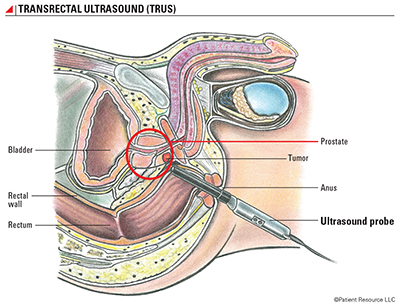Advanced Prostate Cancer
Diagnosing & monitoring
Numerous tests are used to identify and monitor prostate cancer, which also provide clues about the severity of your disease. Once cancer cells have metastasized (spread) from the prostate, doctors will need to pinpoint to which areas the cells have migrated so they can suggest the most effective treatment options for you.
Your symptoms are important clues about the possibility of advanced disease, so be sure to tell your doctor about anything you notice so that he or she can order the appropriate tests to determine if cancer has recurred (returned) or spread. Depending on your symptoms, your doctor can use a variety of tests to detect and monitor your prostate cancer, including a digital rectal exam (DRE), a measurement of the prostate-specific antigen (PSA) in the blood, imaging tests, and a biopsy. In addition, other blood tests and urine studies (urinalysis) may be helpful in determining whether prostate cancer has progressed.
Common tests used to diagnose and monitor prostate cancer include:
- Digital rectal exam (DRE) – A common test performed by doctors or nurses is a digital rectal exam (DRE). For this exam, the doctor inserts a lubricated, gloved finger into your rectum and feels the prostate through the rectal wall. This diagnostic test is also performed throughout treatment to check for progress or recurrences during follow-up visits.
- Prostate-specific antigen (PSA) test – The prostate-specific antigen is a protein produced in the prostate gland by both normal prostate cells and cancerous cells. Some of this protein enters the blood, which means that the PSA level can be measured in a small sample of blood taken from a vein in your arm. Measuring your PSA level is very useful for monitoring the status of disease and assessing the effectiveness of treatment. Your doctor will compare your PSA levels over time and watch for an increase, which may indicate that the cancer has progressed.
- Imaging tests – Imaging tests such as a bone scan, computed tomography (CT) and magnetic resonance imaging (MRI) may be used to identify areas of cancer outside the prostate and to determine whether cancer has recurred after treatment. A ProstaScint scan or a PET scan can be used to detect prostate cancer that has spread to other sites.
If cancer spreads, it’s likely to travel first to nearby lymph nodes and then to the bones (but may involve other organs). A bone scan can detect whether prostate cancer has spread to bones. For this test, a small amount of radioactive material is injected into a vein in your arm. The material will travel through your blood and collect in abnormal cells in the bones. While you lie on a special table, a scanner will detect the radioactive material and create an image of your skeletal system.
A CT or MRI scan of the abdomen or pelvis can determine whether the prostate cancer has spread to nearby organs (known as “locally advanced” disease), the pelvic lymph nodes or the liver, or if the tumor is blocking the urinary tract. With CT, a computer is linked to an X-ray machine, and detailed pictures of areas inside the body are taken from different angles. A dye may be injected into a vein in your arm, or you may be asked to drink a liquid with dye in it to help the organs or tissues show up more clearly on the images. With MRI, magnets, radio waves and a computer are used to make a series of detailed pictures of areas inside the body. Your doctor may also order an X-ray or CT scan of your chest, which may be helpful in identifying prostate cancer that has spread to the lungs.
- Blood tests – Your doctor will frequently test your blood to make sure you are healthy enough to receive treatment and to make sure your hormone levels, blood lipids, blood sugar and blood counts are all normal. These tests will be conducted often and will be an important part of your diagnosis and treatment.
- Transrectal ultrasound (TRUS) – A lubricated probe is inserted into your rectum, and sound waves are used to evaluate your internal organs (Figure 1). TRUS is an important part of the biopsy process, as it helps the doctor guide the needle into the prostate.
- Transrectal prostate biopsy – One of the best ways to definitively diagnose prostate cancer is with a biopsy, which is the removal and microscopic review of tissue by a pathologist (a doctor who specializes in diagnosing disease). Your doctor can also take samples of your pelvic lymph nodes, bones or other organs to determine how advanced your cancer has become. A needle is inserted into the prostate through the wall of the rectum to remove a small tissue sample. This is usually repeated between eight to 18 separate times to gather enough samples to determine if the cancer has spread. Nearby pelvic lymph nodes might also be examined for evaluation; however, this is more involved and usually reserved for a separate appointment. Biopsies also help your treatment team establish your Gleason score (which ranges from 2 to 10 depending on the likelihood that your cancer will spread). The higher the number, the more aggressive the disease and the more likely your cancer will metastasize.
Figure 1




